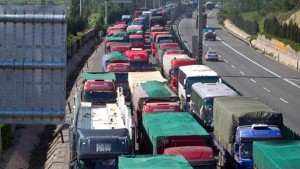
The pollution in China has gotten so bad due, in part, to scenes like this that the government implemented its Red Alert protocol.
Carmakers have been feeling the pinch from the slowdown in the Chinese economy, which has brought the growth of new car sales in China back towards earth.
But the first ever “Red Alert” pollution curbs have been ordered in the sprawling Beijing area, which contains more residents than most European countries or American states. The anti-pollution order included curbs on everything from the outdoor barbecues used by street vendors to giant factories and motorists, who have had to park their vehicles on alternate days much as drivers do in heavily polluted mega-cities, such as Mexico City.
Pollution in Beijing is hardly new phenomena. In fact, the BBC reported a survey of the air around the U.S. Embassy in the center of Beijing by the U.S. Environmental Protection Agency estimated that the air around the embassy compound could be considered healthy 49 % of the time.
During the climate summit in Paris this month, China was described variously as the world’s single-largest contributor to climate change and as having some of the world’s most dangerous air. It also has some of the dirtiest air on the planet. Only India comes close to China in the pollution rankings.
The BBC also reported the Red Alert, which was apparently issued without any sense of irony by authorities in Beijing, where some of the city’s biggest tourist attractions revolve around the 1949 Chinese Revolution when the Red Chinese force routed the armies of the old government, had been even worse before the restrictions took hold.
The municipal authorities in Beijing have been grappled with rapid motorization of the city’s traffic, which up until a decade ago still featured flocks of hundreds of bicyclists. Now the city’s miles of expressways and wide boulevards are choked with traffic that has contributed to the region’s huge pollution problems.
(Aston Martin looking for a new plant location. For more, Click Here.)
They have also tried to restrict the number of automobiles in the region by limiting the new license plates issued each year. The price of the licenses has also increased dramatically.
Most of the newer vehicles now on the road come with the latest pollution controls system from Europe, the United States or Japan. The Chinese authorities, however, are also leaning hard on automakers to electrify the fleet of vehicles. Some cities in Northern China, where the pollution problems are the worst, have begun ordering their taxi fleets to electrify.
(Click Here for details the end of the Nexteer strike in Michigan.)
But as in California the “well-to-wheels” equations haven’t quite balanced yet since a large part of China’s pollution comes from coal-fired power plants built to produce electricity. China also has the world’s largest coal mines.
In addition, as in the rest of the world electric vehicles despite some passionate support haven’t yet proven they are ready for prime time especially in a city like Beijing where the traffic jams can last for hours and drain the life out even the most robust battery-powered car.
(To see more about IIHS and its plans to toughen its standards, Click Here.)
Pollution also is one the major topics discussed on line in China and the Chinese government has given environmental activists a significant amount of latitude to challenge the policies of local governments, according to Chinese experts.
